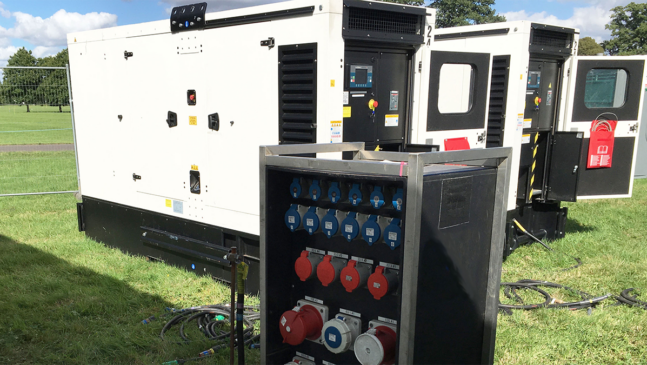Tim Benson, Chair of Powerful Thinking, demystifies electrical jargon essential to understand when seeking sustainable solutions for back up power systems.
Tim suggests that event organisers have the responsibility to push back against both brands and suppliers who prefer unnecessarily oversized synchronized load-sharing generators instead of exploring battery storage solutions or more complex but efficient generator configurations. Could redefining what counts as critical to event operations be key? Overspecced generator back up might be vital for medical, police & fire HQs but perhaps now is the time to put fuel efficiency ahead of uncalled for fuel waste for brand activations or audience convenience? Read the full blog:
“As many of you know, event electrical project managers love to throw a good acronym or a scary bit of jargon into a conversation! With this in mind, you may have heard us use terms like ‘N+1’ and ‘redundancy’ before, but what the devil are we actually talking about?
Both the above examples refer to providing a back-up power system, in the event that the primary supply fails. ‘N+1’ simply means that if you required ‘N’ items of equipment for something to work, you would have one additional spare item; if any one item of equipment breaks down, then everything can still work as intended. Similarly, ‘redundancy’ is defined as the inclusion of extra components which are not strictly necessary to functioning, in case of failure in other components.
All sounds very sensible really, as losing power at an event can have serious consequences, particularly for critical onsite services such as medical triage centres, emergency service compounds (medical, police & fire HQs), lighting for emergency egress, event control centres and their wifi provision. To this end, most power contractors will provide synchronized (sync) load sharing generators, whereby the generators run in parallel and share the total load. Both generators need to be sized such that, if one fails, the other has the capacity to take on the full load. As I’m sure you know, for a generator to run efficiently, it needs to work at +60% of its total generation capacity, but in a load share scenario this can never happen, making it a very unsustainable solution. Furthermore, very few companies supply sync sets under 100kVA, which means that for relatively low wattage critical services, the generators will be oversized, reducing the ratio of fuel consumed to kWhs generated and producing higher levels of emissions.
Other solutions are available to ensure an uninterrupted power supply, for instance; backing-up the generator with a high storage battery system or using a pair of generators with a small battery system and a second generator connected through an AMF panel. The AMF here stands for Automatic Mains Failure, and the panel is a stand-alone unit that calls on the second generator if the primary unit fails. However, generators need to run through their warm-up sequence before outputting power, so a small battery is required here to bridge the gap between the first unit failing and the second unit starting up, reaching its required 1500rpm engine speed and outputting at a frequency of 50Hz. Notably, this kind of system was successfully employed at the Nightingale temporary hospital during the first Covid pandemic.
Whilst both the above solutions are now more widely available, most power contractors will opt for the conventional sync load sharing solution. For critical onsite supplies, we have already established that this is a necessary evil, but where do we draw the line between a power outage being deemed critical versus it simply being inconvenient? The risk averse amongst our ranks will want to back-up virtually everything from stages to food courts, brand activations to open air cinemas, for fear of making audiences irate and possibly even asking for a refund, heaven forbid! Now don’t get me wrong, I completely understand that losing power in some circumstances can trigger reactions from the audience that can lead to serious crowd management issues, and that building in redundancy in these circumstances is prudent.
Similarly, losing stage power can have serious consequences for audio, LX and video equipment, not to mention upsetting show timecode systems, which underpin major stadium concerts. However, event organisers seriously need to take the lead here and reign in this demand for conventional redundancy where power outages cause no major impact, aside from a small dose of inconvenience and a tad of embarrassment. They should speak with their power contractor about alternative solutions and ask them to ensure that regular diagnostic checks are made on all the onsite gensets, so that early interventions can be made before outages occur.
I’ll finish with a quick anecdote that, hopefully, sums up the folly of the demand for non-critical redundancy. Whilst working on a festival in Ireland, I was asked to challenge the request from an agency on behalf of a certain global electronics consumer brand for a pair of sync 150kVAs for an activation that purported to demonstrate the low energy credentials of their LED lighting products. They insisted that this was the only generator configuration that would work, despite their peak load being under 15kW. The response was, ‘it’s what the brand wants so it’s what they should get’. My response… is actually unprintable, sorry!”
This guest blog originally appeared in the July 2022 Vision: 2025 newsletter. Sign up to receive monthly event sustainability news, case studies and guest blogs direct to your inbox www.vision2025.org.uk

